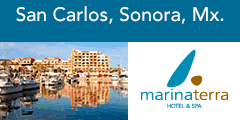Location, Location, Location

Situated between Tetakawi Blvd and the waterfront, the Creston neighborhood is familiar to most San Carlos residents as the southern half of the community’s main commercial strip. Running from the Lavanderia San Carlos in the east, to the newer car wash and office building west of the Ma Rosa Motel, this business area includes many popular restaurants, such as Piccolos, Rosa’s Cantina, Banana’s, and El Gallo, as well as taco and hot dog stands, gift shops, real estate offices, sport/dive shops, doctors, dentists and drug stores, the Rescate clinic and ambulance compound, and, of course, the Creston Motel.
Behind the commercial buildings, the residential area of Creston offers opportunities for varying lifestyles with a delightful mix of houses, from the basic 2 bed/1 bath “San Carlos casitas”, to waterfront villas and walled hacienda-style homes.
Taking its name from the distinctive Cerro El Creston – “Cockscomb Hill” – that divides Creston from San Francisco Beach to the east (Charly’s Rock sits on the wave-soaked foot of the hill), Sector El Creston began to develop in the early 1970’s, when a number of spec houses were built that encouraged American investment in the new community. Now, most of the lots have been developed, and the demand for waterfront property has caused some of the smaller original houses to be drastically renovated or torn down for redevelopment. A few non-waterfront lots remain vacant, but these rarely are available for sale.

According to Karen Stewart, a San Carlos Realtor who lived in El Creston for many years, the area appeals particularly to retired people, especially if they don’t want to be dependent on their cars for everyday activities. “They can walk from their homes to the hairdresser, the dentist, drug stores, any number of great restaurants; even buy groceries close by” she said, “and the roads are lit at night. If I didn’t need my car for work, I could live here without one most of the time”. Karen’s office recently sold a waterfront house listed for US$400,000, a tear-down situated on a 286 square meter lot. She noted that most lots in El Creston are not large, perhaps very few exceeding 500 square meters. And some of the lots have been further subdivided (thereby designated A and B), allowing for a separately-deeded second house. Currently, there are non-waterfront houses listed in Creston in the US$220,000 to $365,000 range, and ownership options include a 2 bedroom apartment (small attached house) for $86,000. There are no large condo developments here, but there are smaller apartment buildings, and many of the houses are available as rentals.
All of the waterfront properties here are accessed from Los Manglares road, which is not continuous through the whole sector. The road’s namesake mangroves are long gone, replaced by palms and bougainvilleas. But at the neighborhood’s western border, along the partly-canalized Mercurio arroyo, you can still imagine a wilder, more tropical setting than you otherwise might expect in “downtown” San Carlos. Starting at Mercurio (Lote Numero Uno is on the waterfront at the eastern outfall of the wash), most of the streets in Creston, connecting Tetakawi Blvd and Manglares, have been named for planets or constellations. Long-time resident Sophia Reid speculates that the area developed in the days when space exploration was an all-consuming passion. She recalls astronaut John Glenn’s call from space – “Hello, Guaymas!” – when his radio identified the satellite-tracking towers still visible on the hills flanking the eastern end of San Francisco Bay.
Because of the sector’s narrow configuration, most non-waterfront homes are only a block from the beaches. Since all beaches are, at least in theory, public property, and must have public access, the drainage arroyos are all pathways to the water. Parking nearby is another matter altogether. The main public beach is at the end of the two blocks between Vista and Neptuno. Here, Manglares is split into west and east sections that do not connect.
The best way to explore Creston is on foot. Parking for cars is a problem, especially where beach access is on a dead-end street. Bikes are ok, but most of the connecting streets are unpaved, the beach section is soft, and oh, those cobblestones! Sophia, who has lived here in a 1972-built waterfront house since 1992, notes that most of the eastern section of Manglares was once nicely cobbled, but the sewer works in the early 1990’s tore up much of it, and the repaved sections have been done at the instigation and expense of adjoining property owners. She also recollected that, even though the neighborhood had no physical community focus such as a community center or park, and there wasn’t (and still isn’t) a home owners’ association to organize events, residents in the eastern part of Creston would host block parties 2 or 3 times a year – themed pot-lucks that brought neighbors together.
Being a waterfront neighborhood, Creston offers unlimited opportunities to experience the ever-changing face of the sea. And, even if you turn your back on the sea, you can still watch the Magnificent Frigates soaring above Cerro El Creston on a windy day.
Whether your idea of a good location is a natural one where you can play in the sea or just relax and observe nature near the coast, or an urban one where you can be close to shops and services, Sector El Creston offers a central location with the best of both worlds.
by John Thomas


















